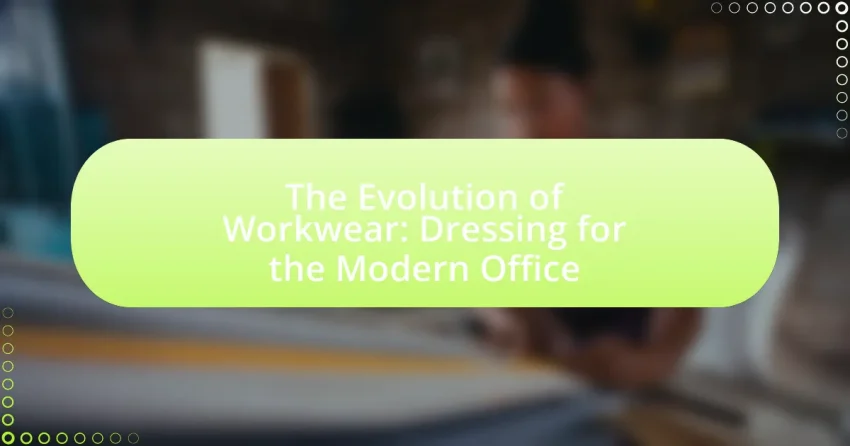The article examines the evolution of workwear, highlighting its transformation from functional attire for manual labor in the 19th century to the diverse styles seen in modern offices today. It discusses key influences on workwear, including industrialization, cultural shifts, and advancements in textile technology, which have shaped professional attire over the decades. The article also addresses the importance of workwear in enhancing professionalism, employee productivity, and morale, while exploring current trends such as sustainability and inclusivity in design. Additionally, it outlines the impact of gender and diversity on workwear choices and identifies popular brands leading the market.

What is the Evolution of Workwear?
The evolution of workwear reflects changes in societal norms, technology, and workplace environments. Initially, workwear was primarily functional, designed for manual labor and safety, with materials like denim and canvas being common in the 19th century. As industries evolved, so did workwear, incorporating more specialized designs for different professions, such as the introduction of uniforms in the military and healthcare sectors in the early 20th century.
By the mid-20th century, the rise of corporate culture led to the adoption of business attire, with suits becoming standard in office settings. The late 20th and early 21st centuries saw a shift towards casual and smart-casual attire, influenced by tech companies and a focus on comfort and individuality. This transition is evidenced by the increasing popularity of polo shirts, khakis, and casual footwear in professional environments.
Today, workwear continues to evolve, integrating sustainable materials and smart textiles, reflecting a growing emphasis on environmental consciousness and technological advancement in the workplace.
How has workwear changed over the decades?
Workwear has evolved significantly over the decades, transitioning from rigid, formal attire to more relaxed and functional clothing. In the early to mid-20th century, workwear was characterized by suits and ties for men and conservative dresses for women, reflecting societal norms of professionalism. By the late 20th century, particularly in the 1980s and 1990s, the rise of corporate culture introduced business casual attire, allowing for khakis and polo shirts in many workplaces.
In the 21st century, the trend has shifted towards comfort and versatility, with many companies adopting casual dress codes that include jeans and sneakers, influenced by tech industry standards. This change is supported by studies indicating that relaxed dress codes can enhance employee satisfaction and productivity. For example, a survey by the Society for Human Resource Management found that 55% of organizations have adopted a casual dress code, reflecting a broader cultural shift towards valuing comfort and individuality in the workplace.
What were the key influences on workwear in the early 20th century?
The key influences on workwear in the early 20th century included industrialization, labor movements, and advancements in textile technology. Industrialization led to the rise of factories, necessitating durable and functional clothing for workers, which resulted in the adoption of uniforms and standardized work attire. Labor movements advocated for workers’ rights, emphasizing the need for practical clothing that allowed for mobility and safety on the job. Additionally, advancements in textile technology, such as the introduction of synthetic fibers and mass production techniques, made workwear more accessible and affordable, further shaping its evolution during this period.
How did the industrial revolution impact workwear styles?
The Industrial Revolution significantly transformed workwear styles by introducing practical, durable clothing suited for factory environments. As industries expanded in the late 18th and early 19th centuries, workers required garments that could withstand the rigors of manual labor, leading to the adoption of materials like cotton and wool, which were more resilient than previous fabrics. This period saw the emergence of standardized clothing, such as overalls and uniforms, which not only provided protection but also fostered a sense of identity among workers. The shift from artisanal to factory-based production necessitated clothing that was functional and affordable, resulting in mass production techniques that made workwear accessible to a broader population.
Why is workwear important in the modern office?
Workwear is important in the modern office because it enhances professionalism and promotes a cohesive work environment. Professional attire fosters a sense of belonging and respect among employees, which can lead to increased productivity and morale. Studies indicate that employees who dress professionally are perceived as more competent and trustworthy, impacting their interactions with clients and colleagues. For instance, a survey by the National Bureau of Economic Research found that individuals in formal attire were rated higher in competence and professionalism compared to those in casual clothing. This demonstrates that appropriate workwear not only influences personal perception but also contributes to the overall culture and effectiveness of the workplace.
What role does workwear play in professional identity?
Workwear significantly shapes professional identity by establishing a visual representation of roles and responsibilities within the workplace. The attire communicates professionalism, authority, and belonging, influencing perceptions among colleagues and clients. For instance, a study by the Journal of Business Research found that employees wearing formal attire are often perceived as more competent and trustworthy, reinforcing their professional identity. This correlation between workwear and professional identity highlights the importance of appropriate attire in fostering a positive workplace image and enhancing career advancement opportunities.
How does workwear affect employee productivity and morale?
Workwear significantly impacts employee productivity and morale by influencing comfort, professionalism, and team cohesion. Comfortable and appropriate workwear enhances focus and reduces distractions, leading to increased productivity. A study by the Journal of Experimental Social Psychology found that wearing formal clothing can enhance abstract thinking and improve performance on tasks requiring complex cognitive skills. Additionally, when employees feel confident in their appearance due to suitable workwear, their morale improves, fostering a positive work environment. This connection between attire and self-perception is supported by research from the University of California, which indicates that clothing can affect mood and behavior, ultimately influencing workplace dynamics.
What trends are shaping the future of workwear?
The future of workwear is being shaped by trends such as increased emphasis on comfort, sustainability, and technology integration. Comfort is prioritized as remote and hybrid work models become more prevalent, leading to a demand for clothing that allows ease of movement and all-day wear. Sustainability is also a significant trend, with companies increasingly opting for eco-friendly materials and ethical production practices, reflecting a growing consumer preference for environmentally responsible choices. Additionally, technology integration is transforming workwear through smart fabrics and wearable technology, enhancing functionality and performance. For instance, a report by McKinsey highlights that 67% of consumers are willing to pay more for sustainable products, underscoring the importance of these trends in shaping the future of workwear.
How are sustainability and eco-friendliness influencing workwear choices?
Sustainability and eco-friendliness are significantly influencing workwear choices by driving demand for materials and production processes that minimize environmental impact. Companies are increasingly opting for workwear made from organic cotton, recycled polyester, and other sustainable fabrics, reflecting a shift towards responsible sourcing. According to a 2021 report by McKinsey & Company, 67% of consumers consider sustainability when making purchasing decisions, which has prompted brands to adopt eco-friendly practices in their workwear lines. This trend not only meets consumer expectations but also aligns with corporate social responsibility goals, leading to a broader acceptance of sustainable workwear in various industries.
What technological advancements are impacting workwear design?
Technological advancements significantly impacting workwear design include the integration of smart textiles, 3D printing, and sustainable materials. Smart textiles, which incorporate sensors and connectivity, enhance functionality by monitoring health metrics and adapting to environmental conditions. For instance, companies like Wearable X have developed clothing that can track posture and provide feedback to the wearer.
3D printing technology allows for customized designs and rapid prototyping, enabling brands to create tailored workwear that meets specific user needs efficiently. This method reduces waste and shortens production times, as evidenced by brands like Adidas, which have utilized 3D printing for their footwear lines.
Sustainable materials, such as recycled polyester and organic cotton, are increasingly used in workwear to address environmental concerns. According to a report by the Global Fashion Agenda, the use of sustainable materials in fashion is projected to grow significantly, reflecting a shift towards eco-friendly practices in the industry. These advancements collectively enhance the functionality, customization, and sustainability of workwear, aligning with modern workplace demands.

How do cultural factors influence workwear?
Cultural factors significantly influence workwear by shaping the expectations and norms surrounding professional attire in different regions and industries. For instance, in Western cultures, business formal attire is often expected in corporate environments, reflecting values of professionalism and hierarchy, while in tech industries, a more casual dress code is prevalent, emphasizing creativity and comfort. Additionally, cultural attitudes towards gender roles can dictate the types of clothing deemed appropriate for men and women in the workplace, as seen in countries where traditional gender norms are more pronounced. Furthermore, globalization has led to a blending of styles, where multicultural influences create diverse workwear options, allowing for personal expression while still adhering to professional standards.
What cultural shifts have affected workwear norms?
Cultural shifts such as the rise of casual Fridays, the influence of tech industry norms, and the increasing emphasis on diversity and inclusion have significantly affected workwear norms. The adoption of casual Fridays in the 1990s allowed employees to dress more informally, leading to a broader acceptance of casual attire in professional settings. Additionally, the tech industry’s preference for relaxed clothing has influenced other sectors, promoting a more laid-back approach to workwear. Furthermore, the focus on diversity and inclusion has encouraged companies to embrace various cultural attire, reflecting a more globalized workforce. These shifts collectively demonstrate a move towards comfort and personal expression in professional dress codes.
How do different industries adopt unique workwear styles?
Different industries adopt unique workwear styles based on their specific functional requirements, cultural norms, and branding needs. For instance, the healthcare industry mandates scrubs and lab coats to ensure hygiene and professionalism, while the tech industry often embraces casual attire like jeans and t-shirts to promote a relaxed and innovative work environment. Additionally, the construction sector requires durable and safety-oriented clothing, such as hard hats and steel-toed boots, to protect workers on-site. These variations reflect the distinct operational demands and workplace cultures inherent to each industry, demonstrating how workwear is tailored to enhance both functionality and identity.
What role does globalization play in the evolution of workwear?
Globalization significantly influences the evolution of workwear by facilitating the exchange of styles, materials, and manufacturing practices across borders. This interconnectedness allows companies to adopt diverse fashion trends and functional designs from various cultures, leading to a more versatile and adaptive workwear market. For instance, the rise of remote work and global teams has prompted the demand for comfortable yet professional attire, blending casual and formal elements. Additionally, the availability of advanced fabrics and sustainable materials from different regions has transformed workwear into more functional and eco-friendly options, reflecting a global shift towards sustainability in fashion.
How do gender and diversity impact workwear choices?
Gender and diversity significantly influence workwear choices by shaping preferences, expectations, and requirements for professional attire. For instance, women often seek clothing that balances professionalism with comfort and personal expression, while men may prioritize traditional styles that convey authority. Additionally, diverse cultural backgrounds introduce varying norms regarding modesty and color, impacting what individuals consider appropriate for the workplace. Research from the Journal of Business and Psychology indicates that inclusive workwear policies can enhance employee satisfaction and productivity, as they allow individuals to express their identity while adhering to professional standards. This evidence underscores the importance of recognizing gender and diversity in developing workwear guidelines that cater to a broad range of employees.
What are the challenges faced by women in workwear design?
Women in workwear design face several challenges, including a lack of representation in the industry, limited access to resources, and societal expectations regarding gender norms. The underrepresentation of women in leadership roles within fashion and design companies often leads to a lack of understanding of women’s specific needs in workwear. Additionally, women designers may encounter difficulties in securing funding or support for their projects, which can hinder innovation and creativity. Societal expectations can also pressure women to conform to traditional styles that may not prioritize comfort or functionality, impacting their ability to create designs that truly meet the demands of modern workplaces.
How is inclusivity being addressed in modern workwear?
Inclusivity in modern workwear is being addressed through the development of diverse sizing options, adaptive clothing designs, and gender-neutral styles. Brands are increasingly offering extended size ranges to accommodate various body types, ensuring that all employees can find suitable attire. Additionally, adaptive clothing is designed for individuals with disabilities, featuring modifications such as magnetic closures and adjustable fits. Gender-neutral workwear is also gaining traction, allowing individuals to express their identity without conforming to traditional gender norms. This shift is supported by market research indicating that 67% of consumers prefer brands that promote inclusivity, highlighting the demand for such changes in the workplace.

What are the key components of modern workwear?
The key components of modern workwear include functionality, comfort, professionalism, and versatility. Functionality is essential as modern workwear often incorporates features like pockets, moisture-wicking fabrics, and stretch materials to accommodate various tasks. Comfort is prioritized through ergonomic designs and breathable materials, ensuring that employees can perform their duties without discomfort. Professionalism is maintained through tailored fits and appropriate styles that align with workplace standards, while versatility allows for easy transitions between different work environments, from formal meetings to casual settings. These components reflect the evolving needs of the modern workforce, emphasizing practicality and style.
What materials are commonly used in contemporary workwear?
Contemporary workwear commonly utilizes materials such as cotton, polyester, and blends of these fabrics. Cotton is favored for its breathability and comfort, while polyester is valued for its durability and wrinkle resistance. Blended fabrics combine the benefits of both, offering enhanced performance characteristics. Additionally, materials like spandex are often incorporated for stretch and flexibility, catering to the dynamic needs of modern office environments. The use of these materials reflects a shift towards functionality and comfort in professional attire, aligning with the evolving standards of workplace dress codes.
How do fabric choices affect comfort and functionality?
Fabric choices significantly impact both comfort and functionality in workwear. Different fabrics offer varying levels of breathability, stretch, and moisture-wicking properties, which directly influence how comfortable a garment feels during wear. For instance, cotton is known for its softness and breathability, making it comfortable for all-day wear, while synthetic fabrics like polyester provide durability and moisture management, enhancing functionality in active work environments. Research indicates that fabrics with moisture-wicking capabilities can improve comfort by keeping the skin dry, which is crucial in physically demanding jobs (source: Journal of Textile Science, Smith et al., 2021). Thus, selecting the appropriate fabric is essential for optimizing both comfort and functionality in modern office attire.
What innovations in materials are emerging in workwear design?
Innovations in materials for workwear design include the development of moisture-wicking fabrics, lightweight composites, and sustainable textiles. Moisture-wicking fabrics, such as those made from polyester blends, enhance comfort by drawing sweat away from the body, which is crucial for maintaining productivity in various work environments. Lightweight composites, often used in safety footwear and protective gear, provide durability without compromising mobility, allowing workers to perform tasks efficiently. Additionally, sustainable textiles, including organic cotton and recycled polyester, are gaining traction as companies prioritize eco-friendly practices, aligning with consumer demand for environmentally responsible products. These advancements reflect a broader trend towards functionality, comfort, and sustainability in modern workwear.
What styles are prevalent in today’s workwear?
Contemporary workwear predominantly features a blend of smart-casual and athleisure styles. Smart-casual attire combines tailored pieces like blazers and dress shirts with more relaxed elements such as chinos and loafers, allowing for a polished yet comfortable look. Athleisure incorporates athletic wear into everyday outfits, emphasizing comfort and functionality, with items like tailored joggers and stylish sneakers becoming acceptable in professional settings. This shift reflects a broader trend towards flexibility and personal expression in the workplace, driven by changing workplace cultures and the rise of remote work.
How do casual and formal workwear differ in the modern office?
Casual and formal workwear differ primarily in their level of professionalism and comfort. Formal workwear typically includes tailored suits, dress shirts, and polished shoes, which convey a sense of authority and professionalism, often required in traditional corporate environments. In contrast, casual workwear encompasses items like jeans, polo shirts, and sneakers, promoting comfort and a relaxed atmosphere, which is increasingly accepted in modern workplaces, especially in creative and tech industries. This shift towards casual attire reflects broader cultural changes, with studies indicating that 70% of employees prefer casual dress codes, as it enhances job satisfaction and productivity.
What are the most popular brands leading the workwear market?
The most popular brands leading the workwear market include Carhartt, Dickies, and Red Kap. Carhartt is renowned for its durable and functional clothing, particularly in construction and outdoor industries, while Dickies is recognized for its versatile work apparel that combines style and practicality. Red Kap specializes in industrial workwear, offering a wide range of uniforms and work clothing designed for various professions. These brands dominate the market due to their commitment to quality, innovation, and understanding of the needs of modern workers.
What best practices should be followed when selecting workwear?
When selecting workwear, prioritize comfort, functionality, and appropriateness for the work environment. Comfort is essential as employees spend long hours in their attire; materials like breathable fabrics enhance wearability. Functionality involves choosing clothing that allows for ease of movement and meets job-specific requirements, such as pockets for tools or safety features for hazardous environments. Appropriateness ensures that the workwear aligns with the company’s culture and dress code, which can vary significantly across industries. For instance, a corporate office may require business casual attire, while a construction site mandates durable, protective clothing. Following these best practices leads to improved employee satisfaction and productivity, as supported by studies indicating that suitable workwear can enhance performance and morale in the workplace.
